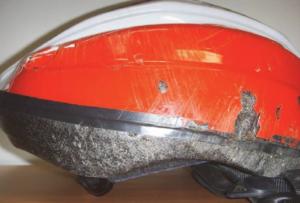EVU XXIV 2015-14 Dynamic Testing of Bicycle Helmets in order to Forensically Validate or Invalidate Alleged Real-World Vehicle- Cyclist Collisions
Dynamic Testing of Bicycle Helmets in
order to Forensically Validate or
Invalidate Alleged Real-World Vehicle-
Cyclist Collisions
Tia Gaffney, Nikola Josevski, Andreas Sandvik,
Blake Winter, Shane Richardson
Abstract
When a cyclist is involved in a real-world impact, the offending vehicle occasionally leaves
the scene (e.g. hit and run). Often, there are no witnesses and the impacted cyclist has
little or no recollection about the collision events. In these instances, a forensic
investigation of the collision is required in order to determine whether a phantom vehicle
has been involved or, alternately, whether the cyclist has simply fallen and impacted the
ground surface.
A series of dynamic impact tests were conducted in order to forensically evaluate the
performance of bicycle helmets when impacted in environments intended to replicate realworld
collisions between cyclists and vehicles. The first series of tests involved dynamic
drop tests of helmeted 5-7kg surrogate headforms dropped from heights of 5 metres to 15
metres (to simulate different impact speeds) onto protruding metal objects, as well as from
a nominal riding height of 1.3 metres onto a gravel road at 20km/h, 30km/h and 40km/h.
The second series of tests involved impacts to a helmeted semi-rigid inverted pendulum
with a total system mass of 55kg to 65kg. The inverted pendulum assembly was
subjected to two types of dynamic helmet impact tests: A) Rotational free-fall helmet
impact with the ground surface from nominal riding height and B) Helmet impact with a
vehicle side rear-view mirror assembly (with incremental vehicle impact speeds of 20km/h
to 60km/h).
The helmet damage sustained in each test was documented and recorded
photographically and videographically. The post-impact results were then compared to
the helmet damage sustained in real-world cyclist collisions with alleged vehicle
involvement. The test results enabled scientific investigators to accept or reject
hypotheses presented regarding the alleged collision events.

La lettura di questo articolo è riservata ai soli Soci EVU Italia
| Autore | Tia Gaffney, Nikola Josevski, Andreas Sandvik, Blake Winter, Shane Richardson |
| Pubblicato il | |
| Tipologia |
